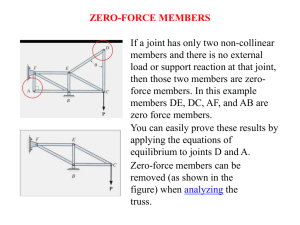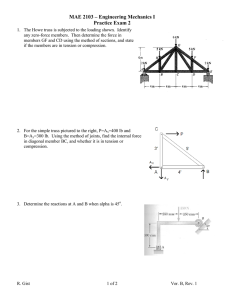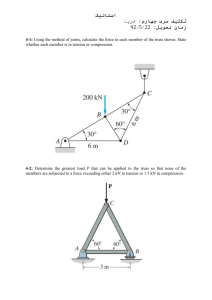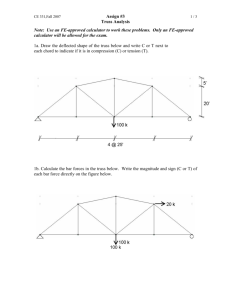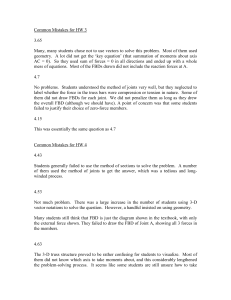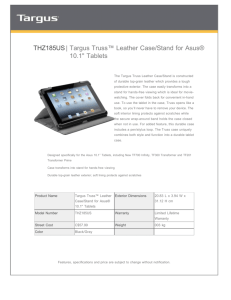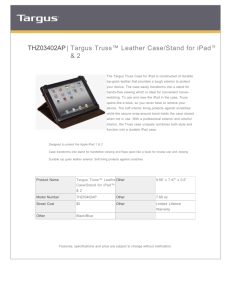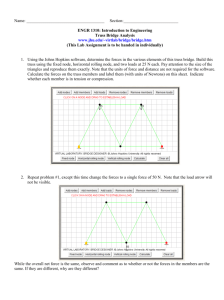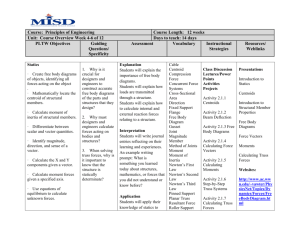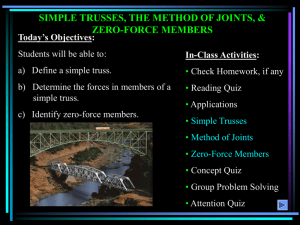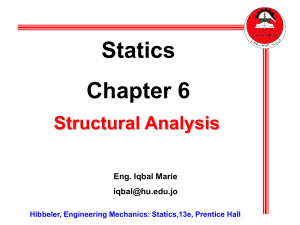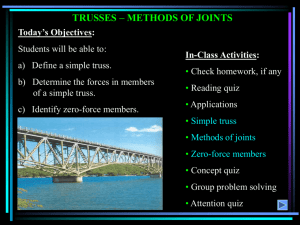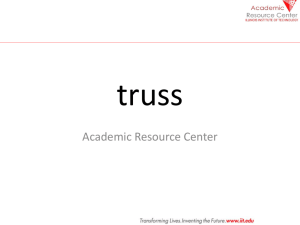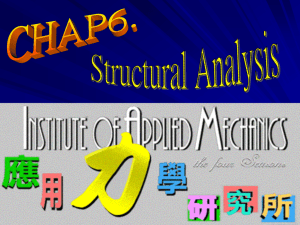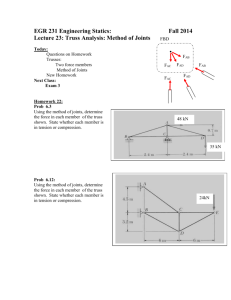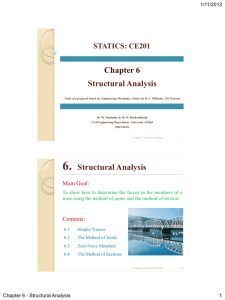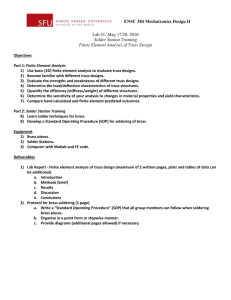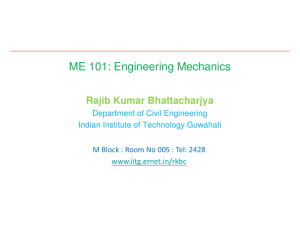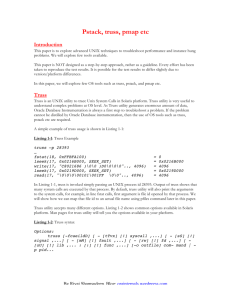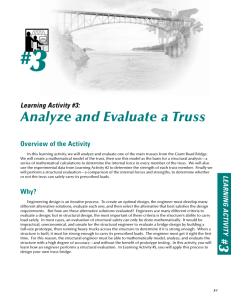IEA-Spring2004-RetestFinal-Solution
advertisement
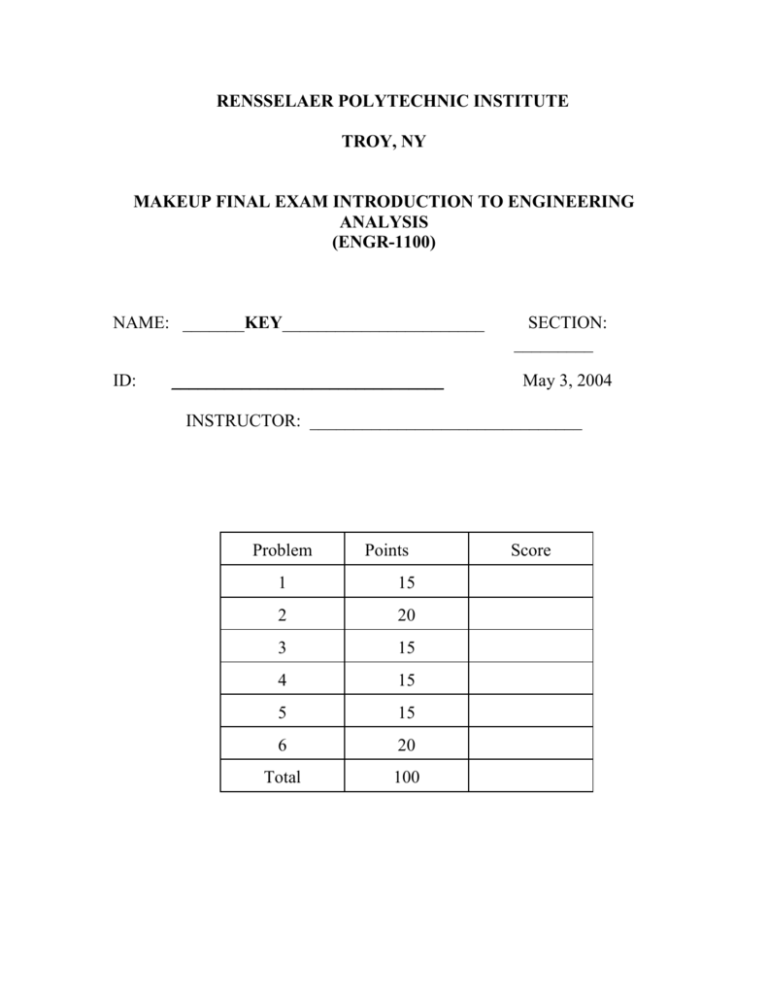
RENSSELAER POLYTECHNIC INSTITUTE TROY, NY MAKEUP FINAL EXAM INTRODUCTION TO ENGINEERING ANALYSIS (ENGR-1100) NAME: _______KEY_______________________ ID: _______________________________ SECTION: _________ May 3, 2004 INSTRUCTOR: _______________________________ Problem Points 1 15 2 20 3 15 4 15 5 15 6 20 Total 100 Score PROBLEM 3 (15 points) Rod AB is subjected to the 200N force as shown. BE and BD are two cables which connect the rod to the two hooks at E and D, respectively. The support at A is a ball and a socket. z y x (i) Draw a neat free body diagram of the rod AB. (5 pt) (ii) Determine the tension in cable BD. (5 pt) (iii) Determine the tension in cable BE. (5 pt) (i) rAC rAB (ii) The forces in Cartesian form are FA Ax i Ay j Az k TE TE i TD TD j F 200k ( N ) Summing the moments about point A yields M A rAC F rAB TE TD 0 From geometry Coordinates of A (0,0,0) Coordinates of B (1,2,-2) NOTE: The absolute values of the coordinates will depend on the coordinate system chosen but the position vector rAB will not. rAB i 2 j 2k 1 rAB 0.5i j k 2 Hence rAC 0.5i j k 200k i 2 j 2k TE i TD j 0 Expanding and rearranging the terms gives 2TD 200 i 2TE 100 j (TD 2TE )k 0 Hence (iii) TD 100 ( N ) TE 50 ( N ) NOTE: The same answers will be obtained (without any vector analysis) by computing the scalar components of the moments about the x- and y-axes. PROBLEM 5 (15 pt) 1) Read the following statements about a planar truss. (3 pt) I. All truss members are connected at their ends by frictionless pins II. In the method of joints, each joint provides only two independent equilibrium equations III. Truss members can carry only compression forces IV. In the method of sections, each section of the truss provides only two equilibrium equations V. Truss members are loaded at their ends only Which ones of these statements are correct? (Circle one) A. All of them B. Only I, II, and V C. Only I, IV, and V D. Only I and V E. Only III and IV F. Only II, IV, and V 2) Which one of the following statements is true about the planar truss shown below? (3 pt) A. There are no zero-force members in this truss B. Both AB and EF are zero-force members C. This truss is statically indeterminate D. Both EF and DF are zero-force members E. Only CD is a zero-force member F. Only AB is a zero-force member 400 lb 20 ft 200 lb F E 20 ft 300 lb D C 20 ft B A 30 ft 3) Draw a complete free body diagram for the entire truss. The complete free body diagram should include all relevant forces and couples, coordinate axis, and proper dimensions. (3 pt) 4) Find the support reaction at B? (3 pt) 5) Find the force in member CE? (Hint: Consider using the method of joints.) (3 pt) PROBLEM 6 (20 pt) Member ABC is loaded and supported as shown in the figure. The member has a uniform cross section and weighs 5000 N. 1) Determine the resultant R of the distributed load and locate its line of action with respect to the left support for the beam (point A). (3 pt) 2) Draw a complete free body diagram that will assist you to solve the external support reaction. The complete free body diagram should include all relevant forces and couples, coordinate axis, and proper dimensions. (5 pt) 3) The sufficient and necessary equilibrium equations required to solve the external support reaction on the beam are (please circle the most accurate answer): (2 pt) a. Fx=0,Fy=0 b. Fx=0,Fy=0, Fz=0 c. Fx=0,Fy=0, MA=0 d. Fx=0,Fy=0, MB=0 e. Fx=0,Fy=0, MA=0,MB=0 f. Fx=0,MB=0, MA=0 g. All of the above h. Only answer (c), (d), and (f) i. Only answer (b), (d), and (f) j. Only answer (b), (c), (d), and (f) 4) Find the support reaction at A. (5 pt) 5) A smooth pin replaces the support at A, and a roller is placed at C (see figure below). How would that affect the reaction support at A: (3 pt) a. Ax and Ay will not change, and MA=0. b. Ax will not change. Ay will decrease and MA=0. c. Ax will not change. Ay and MA will increase. d. Ax will not change. Ay will increase and MA will decrease by 1/2. e. Ax and Ay will increase, and MA=0. f. Ax and Ay will decrease, and MA=0. g. The information provided is not sufficient to answer the question. 6) The distributed load is now between point A and B, as shown in the figure, how would that affect the reaction at A: (2 pt) a. Ax and Ay will not change. MA will decrease. b. Ax will not change. Ay will decrease and MA=0. c. Ax will not change. Ay and MA will increase. d. Ax will not change. Ay will increase and MA will decrease by 1/2. e. Ax and Ay will increase, and MA=0. f. Ax and Ay will decrease, and MA=0. g. The information provided is not sufficient to answer the question. 3m 5000 N C A 1500 5 5000 3 0 C A 22500 ( N .m) or C A 22500 N .m (CounterClockWise) F y 0 Ay 6500 ( N )
